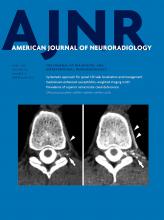Abstract
BACKGROUND AND PURPOSE: Parenchymal hemorrhage is a severe complication following mechanical recanalization in patients with acute ischemic stroke with large-vessel occlusion. This study aimed to assess whether the metallic hyperdensity sign on noncontrast CT performed immediately after mechanical thrombectomy can predict parenchymal hemorrhage at 24 hours.
MATERIALS AND METHODS: We included consecutive patients with acute ischemic stroke with large-vessel occlusion who underwent noncontrast CT immediately after mechanical thrombectomy between January 2014 and September 2018. The metallic hyperdensity sign was defined as a nonpetechial intracerebral hyperdense lesion (diameter, ≥1 cm) in the basal ganglia and a maximum CT density of >90 HU. The sensitivity, specificity, and positive and negative predictive values of the metallic hyperdensity sign in predicting parenchymal hemorrhage were calculated.
RESULTS: A total of 198 patients were included. The metallic hyperdensity sign was found in 59 (29.7%) patients, and 51 (25.7%) patients had parenchymal hemorrhage at 24 hours. Patients with the metallic hyperdensity sign are more likely to have parenchymal hemorrhage than those without it (76.3% versus 4.3%, P < .001). The sensitivity, specificity, positive predictive value, and negative predictive value of the metallic hyperdensity sign in predicting parenchymal hemorrhage were 88.2%, 90.5%, 76.3%, and 95.7%, respectively.
CONCLUSIONS: The presence of the metallic hyperdensity sign on noncontrast CT performed immediately after mechanical thrombectomy in patients with large-vessel occlusion could predict the occurrence of parenchymal hemorrhage at 24 hours, which might be helpful in postinterventional management within 24 hours after mechanical thrombectomy.
ABBREVIATIONS:
- HT
- hemorrhagic transformation
- MT
- mechanical thrombectomy
- PH
- parenchymal hemorrhage
- © 2019 by American Journal of Neuroradiology
Indicates open access to non-subscribers at www.ajnr.org












